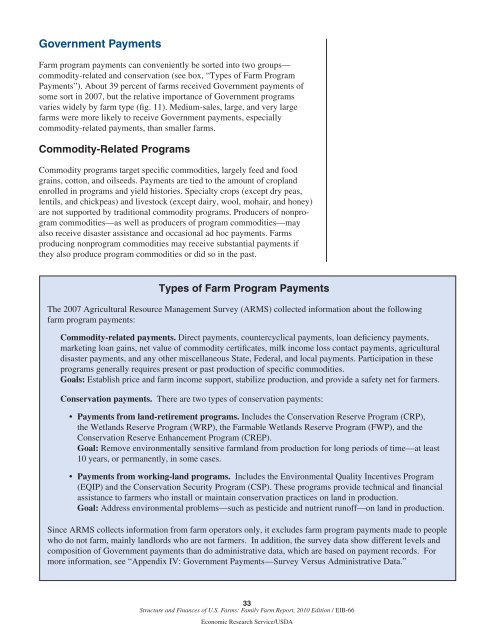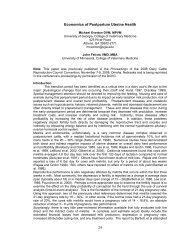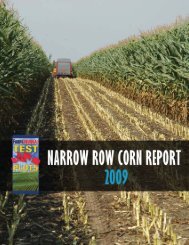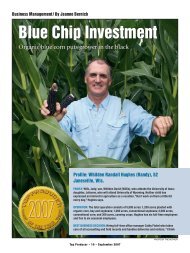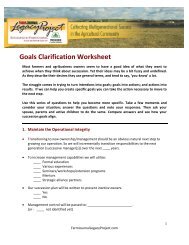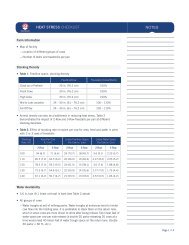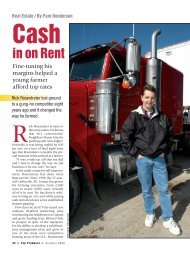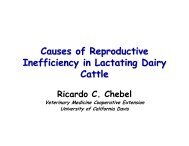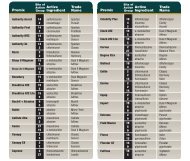Structure and Finances of U.S. Farms: Family Farm Report ... - AgWeb
Structure and Finances of U.S. Farms: Family Farm Report ... - AgWeb
Structure and Finances of U.S. Farms: Family Farm Report ... - AgWeb
Create successful ePaper yourself
Turn your PDF publications into a flip-book with our unique Google optimized e-Paper software.
Government Payments<strong>Farm</strong> program payments can conveniently be sorted into two groups—commodity-related <strong>and</strong> conservation (see box, “Types <strong>of</strong> <strong>Farm</strong> ProgramPayments”). About 39 percent <strong>of</strong> farms received Government payments <strong>of</strong>some sort in 2007, but the relative importance <strong>of</strong> Government programsvaries widely by farm type (fig. 11). Medium-sales, large, <strong>and</strong> very largefarms were more likely to receive Government payments, especiallycommodity-related payments, than smaller farms.Commodity-Related ProgramsCommodity programs target specific commodities, largely feed <strong>and</strong> foodgrains, cotton, <strong>and</strong> oilseeds. Payments are tied to the amount <strong>of</strong> cropl<strong>and</strong>enrolled in programs <strong>and</strong> yield histories. Specialty crops (except dry peas,lentils, <strong>and</strong> chickpeas) <strong>and</strong> livestock (except dairy, wool, mohair, <strong>and</strong> honey)are not supported by traditional commodity programs. Producers <strong>of</strong> nonprogramcommodities—as well as producers <strong>of</strong> program commodities—mayalso receive disaster assistance <strong>and</strong> occasional ad hoc payments. <strong><strong>Farm</strong>s</strong>producing nonprogram commodities may receive substantial payments ifthey also produce program commodities or did so in the past.Types <strong>of</strong> <strong>Farm</strong> Program PaymentsThe 2007 Agricultural Resource Management Survey (ARMS) collected information about the followingfarm program payments:Commodity-related payments. Direct payments, countercyclical payments, loan deficiency payments,marketing loan gains, net value <strong>of</strong> commodity certificates, milk income loss contact payments, agriculturaldisaster payments, <strong>and</strong> any other miscellaneous State, Federal, <strong>and</strong> local payments. Participation in theseprograms generally requires present or past production <strong>of</strong> specific commodities.Goals: Establish price <strong>and</strong> farm income support, stabilize production, <strong>and</strong> provide a safety net for farmers.Conservation payments. There are two types <strong>of</strong> conservation payments:• Payments from l<strong>and</strong>-retirement programs. Includes the Conservation Reserve Program (CRP),the Wetl<strong>and</strong>s Reserve Program (WRP), the <strong>Farm</strong>able Wetl<strong>and</strong>s Reserve Program (FWP), <strong>and</strong> theConservation Reserve Enhancement Program (CREP).Goal: Remove environmentally sensitive farml<strong>and</strong> from production for long periods <strong>of</strong> time—at least10 years, or permanently, in some cases.• Payments from working-l<strong>and</strong> programs. Includes the Environmental Quality Incentives Program(EQIP) <strong>and</strong> the Conservation Security Program (CSP). These programs provide technical <strong>and</strong> financialassistance to farmers who install or maintain conservation practices on l<strong>and</strong> in production.Goal: Address environmental problems—such as pesticide <strong>and</strong> nutrient run<strong>of</strong>f—on l<strong>and</strong> in production.Since ARMS collects information from farm operators only, it excludes farm program payments made to peoplewho do not farm, mainly l<strong>and</strong>lords who are not farmers. In addition, the survey data show different levels <strong>and</strong>composition <strong>of</strong> Government payments than do administrative data, which are based on payment records. Formore information, see “Appendix IV: Government Payments—Survey Versus Administrative Data.”33<strong>Structure</strong> <strong>and</strong> <strong>Finances</strong> <strong>of</strong> U.S. <strong><strong>Farm</strong>s</strong>: <strong>Family</strong> <strong>Farm</strong> <strong>Report</strong>, 2010 Edition / EIB-66Economic Research Service/USDA


